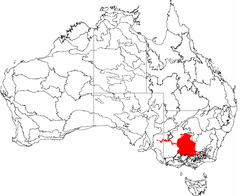Riverina
The Riverina (pronounced /rɪvəˈriːnə/)[1] is a large farming area in the south west of New South Wales, Australia. It has flat plains, warm to hot climate and a large supply of water for irrigation. This has allowed the Riverina to become one of the most productive and agriculturally varied areas of Australia. With the state of Victoria to the south, and the mountains of the Great Dividing Range to the east, the Riverina covers those areas of New South Wales in the Murray and Murrumbidgee river systems.
| Riverina New South Wales | |||||||||||||||
|---|---|---|---|---|---|---|---|---|---|---|---|---|---|---|---|
 The Murrumbidgee River at Wagga Wagga | |||||||||||||||
| Coordinates | 35°S 146°E / 35°S 146°ECoordinates: 35°S 146°E / 35°S 146°E | ||||||||||||||
| Population | 255,881 (2001) | ||||||||||||||
| LGA(s) | Various | ||||||||||||||
| State electorate(s) | |||||||||||||||
| Federal division(s) | |||||||||||||||
| |||||||||||||||
The Riverina has been home to Aboriginal groups for over 40,000 years. It was first settled by Europens in the mid-19th century as a pastoral region growing beef and wool for markets in Australia and overseas. In the 20th century, the building of major irrigation areas in the Murray and Murrumbidgee valleys has led to the introduction of crops such as rice and grapes. The Riverina has strong links to Victoria, and the region was the source of much of the push behind the federation of Australian colonies.
The major cities and towns in the Riverina include Wagga Wagga, Albury and Griffith. Albury and Wagga Wagga are home to campuses of Charles Sturt University. Wagga Wagga is home to two major Australian Defence Force bases.
Geography
The area of the Riverina region is not fixed, but it usually includes the farming and pastoral areas of New South Wales, west of the Great Dividing Range and in the drainage basin of the snow-fed Murray and Murrumbidgee Rivers.[2] The north edge of the Riverina is the Lachlan River catchment area known as the Central West. Along the Murray to the south, the Riverina border is the state of Victoria. West of where the Murray and Murrumbidgee meet, is the beginning of the drier Far West region.
In general, the Riverina is an alluvial plain formed by soil carried from the Great Dividing Range by streams between 30,000 and 15,000 years ago.[3] The landscape includes rolling hills to the east but then becomes flatter to the west with most of that plain reaching less than 200 metres (660 ft) above sea level. The western Riverina is mainly flat saltbush plain.
Landforms and water

The geology of the Riverina has several troughs and sedimentary basins. The western Riverina is thought to be the end of the Ballarat and Bendigo geological zone. The eastern part is over the top of the western part of the Lachlan Fold Belt. It is possible that the Riverina has mineral deposits including coal, petroleum, coal seam methane, gypsum, gold, Cobar style polymetallic systems, heavy mineral sands and possibly diamonds in these fold belt rocks and basins.[3][4] Riverina soils are generally sandy along the rivers, with more saline grey and brown clays found on rarely flooded areas on the edge of the floodplain. As the Murrumbidgee flows downstream, the water and soil become more saline.[3]
The Riverina is drained by the large Murray-Darling Basin. Rivers and streams in the Riverina generally flow east to west. As well as the Murray, Murrumbidgee and Lachlan, other streams include Billabong Creek and the Edward River, an anabranch of the Murray. Much of the water carried by these streams is taken out for other uses. In 2001–2002, 52% of the Murray and Murrumbidgee water was taken, with 77% of that water used for irrigation.[5]
Riverina Media
Charles Sturt, the first European to follow the Murrumbidgee River downstream to the Murray.
The Old Moulamein Wharf, on the Edward River, was constructed in 1908. Moulamein prospered as an inland port until the coming of the railways in 1926.
Junee railway station is a junction for the Melbourne XPT passenger service
A 1916 map of the Riverina. The area where Griffith and Leeton would later be built was largely uninhabited until the development of the Murrumbidgee Irrigation Area.
A centre pivot irrigation system near Euberta. Much of the agricultural industry in the Riverina relies on irrigation.
References
- ↑ Macquarie Dictionary, Fourth Edition (2005). Melbourne, The Macquarie Library Pty Ltd. ISBN 1-876429-14-3
- ↑ "Riverina Region Map (pdf)" (PDF). Archived from the original (PDF) on 2011-07-17. Retrieved 2010-03-08.
- ↑ 3.0 3.1 3.2 "Riverina - Landform". National Parks and Wildlife Service, New South Wales. Archived from the original on 2006-09-11. Retrieved 2007-01-31.
- ↑ "Riverina Western Regional Assessment". New South Wales Department of Primary Industries. Archived from the original on 2006-10-04. Retrieved 2007-01-23.
- ↑ Meyer, Wayne (2005). "The Irrigation Industry in the Murray and Murrumbidgee Basins" (PDF). CRC for Irrigation Futures Technical Report No. 03/05. CRC for Irrigation Futures. Archived from the original (PDF) on 2006-09-18. Retrieved 2007-02-01.








